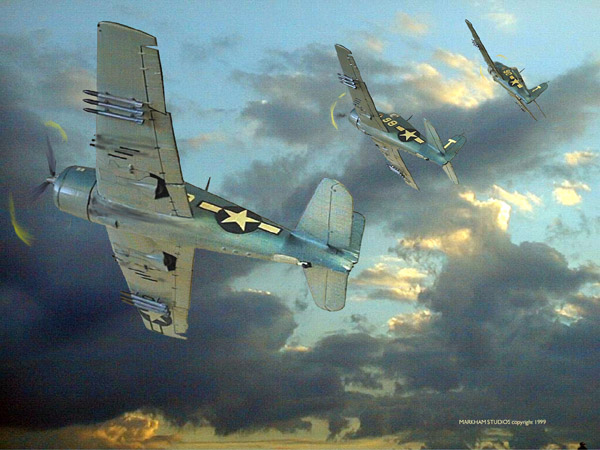Here it is the new aircraft of the week, as you have probably read in the poll post the Spitfire was the techincal winner by one vote, but since the Hellcat has had four or more votes every week since the start I decided that its time for it to have the spot light, so here it is the F6F Hellcat.
Remember to put any pics of your models or any interesting pics of the fighter you come across.
 GRUMMAN F6F HELLCAT
GRUMMAN F6F HELLCAT
Although the Grumman F6F Hellcat was not as spectacular a performer as the Vought F4U Corsair, it was the strong point of carrier-based aviation in the U.S. Navy during the last two years of the war. Only 14 months elapsed between the prototype's first flight and the plane's debut in combat. From August 31, 1943, until the war ended, the 12,272 Hellcats proved to be worthy successors of the Wildcats. According to U.S. Navy records, of the 6,477 enemy planes destroyed in air combat by carrier-based planes, 4,947 were downed by F6Fs. This total reaches 5,156 if one adds the victories of the land-based Hellcats piloted by Marines.
Production was intense. During 1943, a total of 2,545 F6F-3s were delivered. Of these, 252 went to Britain's Fleet Air Arm. The British called the plane Hellcat Mk.I and put it into service in July. Before production switched over to F6F-5s, in April, 1944, a total of 4,403 F6F-3s were built. Of these, 223 aircraft were equipped for night fighting. These planes were known as F6F-3E and F6F-3N and carried radar equipment in a fairing under the starboard wing.
The first Hellcat of the largest production version, the F6F-5, took to the air on April 4, 1944. The main difference from its predecessor was in the engine, a 2,200-h.p. Pratt & Whitney R-2800-1OW Double Wasp. There were also modifications to the engine cowling, the windshield, and the ailerons; the tail was reinforced, and additional armor was installed to the rear of the pilot. Armament was also increased, and 2,000 pounds of bombs or six rockets could be carried under the wings. A total of 7,868 F6F-5s were built, including a series for night fighting, the F6F-5N. A total of 1,434 of these night fighters were built, modified right on the assembly line. Of the 932 Hellcats received by the British navy, 70 of them were radar-equipped and were known as Hellcat Mk.II. A final derivative series was produced in small numbers. This was the F6F-5P, for photographic reconnaissance. Production ended in November, 1945. The operational career of the Hellcat began on August 31, 1943, with the attack on Japanese installations on Marcus Island. The planes were in the air for the rest of the war, in all air-sea operations and in amphibian operations. The F6F saw duty as a fighter, fighter bomber, and night fighter and made a great name for itself. It was far superior to the leading Japanese combat planes, including the Mitsubishi A6M Reisen, the Zero. Although the Hellcat was less agile than the Zero, it was far tougher and better armed. Not only were Hellcats more powerful, they were far more numerous. One of the outstanding enterprises of the plane's career was the "Marianas Turkey Shoot" on June 19 and 20, 1944, during the Battle of the Philippine Sea, the last great aircraft carrier encounter of the war. Hellcats with accurate radar control wiped out the Japanese attack force, destroying some 400 aircraft.
Type: Fighter
Crew: Pilot
Armament: six .50 cal machine guns
Specifications
Length: 33' 7" (10.24 m)
Height: 13' 1" (3.99 m)
Wingspan: 42' 10" (13.5 m)
Wing area: 3344 sq. ft (313 sq. m)
Empty Weight: 9238 lbs (4189 kg)
Gross Weight: 15412 lbs (6990 kg)
Max Weight: 15413 lbs (6990 kg)
Propulsion
No. of Engines: 1
Powerplant: Pratt & Whitney R-2800-10W
Horsepower: 2000 hp
Performance
Range: 945 miles (1521 km)
Cruise Speed: 168 mph (270 km/hr)
Max Speed: 380 mph (611 km/hr)
Climb: 2980 ft/min (908.26 m/min)
Ceiling: 37300 ft (11368 m)
 Markings/ Paint Schemes.
Markings/ Paint Schemes.

Pacific Theater paint sheme, red surrounded insignea early version, F6F-3

Fleet Air Arm F6F
Model Aircraft Reviews (F6F)
1/72 F6F-3 Academy
http://modelingmadness.com/scotts/allies/us/acadf6f.htm
1/72 F6F-3 Airfix
http://modelingmadness.com/reviews/allies/us/hedgef6f.htm
1/72 F6F-3 Italeri
http://modelingmadness.com/reviews/allies/us/lacombef6f.htm
1/72 F6F-3 Hasegawa
http://modelingmadness.com/reviews/allies/us/acostaf6f.htm
1/72 F6F-5 Hasegawa
http://modelingmadness.com/scotts/allies/us/f6f5n.htm
1/48 F6F-3 Arii/Otaki
http://modelingmadness.com/reviews/allies/us/feyf6f.htm
1/48 F6F-3 Hasegawa
http://modelingmadness.com/scotts/allies/us/f6f3.htm
http://modelingmadness.com/reviews/allies/us/cleaverf6f.htm
1/48 F6F-5 Monogram Classics
http://modelingmadness.com/reviews/allies/us/lacombemcf6f.htm
1/32 F6F-5 Hasegawa
http://modelingmadness.com/reviews/allies/us/cookf6f.htm
Had some trouble finding good pictures of all the diferebt varients of the F6F so unfortunetly there will be none, but I hope I made up for it with all the extra info I found.
enjoy
![Big Smile [:D]](/FSM/CS/emoticons/icon_smile_big.gif)
The skies the limit,
V.A.